Gauss gun - the tale of 3% efficiency
 Somehow on the Internet, I found an article about a Gauss gun and thought about the fact that it would be nice to have one (or even two). In the process of searching, I stumbled upon the gauss2k website and, using the simplest scheme, assembled a super-cool mega-gauss cannon.
Somehow on the Internet, I found an article about a Gauss gun and thought about the fact that it would be nice to have one (or even two). In the process of searching, I stumbled upon the gauss2k website and, using the simplest scheme, assembled a super-cool mega-gauss cannon.Here she is:

')
And he shot a little:
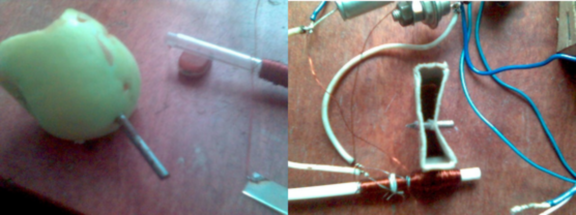
And she took me here sadness-strong sadness about the fact that I am not a super-cool gun, but also - a pukalka, of which there are many. I sat down and began to think about how I can improve efficiency. Long thought. Year. I read the whole gauss2k and the pioneering forum. Invented.
It turns out that there is a program written by overseas scientists, and our craftsmen under gauss cannon dopilennaya, and it is called nothing other than FEMM .
I downloaded a script from the .lua forum and an overseas version 4.2 program and got ready to hit the scientific calculations. But it was not here that the overseas program did not want to launch the Russian script, because the script for the 4.0 version was made. And I opened the instruction (they have a manual for it) in the Burzhuinsky language and burned it completely. I discovered the great truth that in the script, damned, you must first add a tricky line.
Here she is:
setcompatibilitymode(1) -- femm 4.2 And I sat down at the calculations for a long time, my calculating machine buzzed, and I received a description of the academic:
Description
Capacitor capacitance, microfarad = 680
Voltage on the capacitor, Volt = 200
The total resistance, Ohm = 1.800147899376892
External resistance, Ohm = 0.5558823529411765
Coil resistance, Ohm = 1.244265546435716
The number of turns in the coil = 502.1193771626296
The diameter of the winding wire coil millimeter = 0.64
The length of the wire in the coil, meter = 22.87309092387464
Coil length, millimeter = 26
The outer diameter of the coil, millimeter = 24
The inductance of the bullet coil in the initial position, microHenry = 1044.92294174225
External diameter of the barrel, millimeter = 5
Bullet weight, gram = 2.450442269800038
Bullet length, millimeter = 25
Bullet diameter, millimeter = 4
The distance at which the bullet was inserted into the coil at the initial moment, millimeter = 0
Material from which the bullet is made = No. 154 Experimentally selected material (simple iron)
Process time (microseck) = 4800
Time increment, microseck = 100
The energy of the bullet j = 0.2765589667129519
Capacitor energy j = 13.6
Gaus efficiency (%) = 2.033521814065823
Initial bullet speed, m / s = 0
Bullet speed at the exit of the coil, m / s = 15.02403657199634
The maximum speed that was achieved, m / s = 15.55034094445013
Voltage on the capacitor, Volt = 200
The total resistance, Ohm = 1.800147899376892
External resistance, Ohm = 0.5558823529411765
Coil resistance, Ohm = 1.244265546435716
The number of turns in the coil = 502.1193771626296
The diameter of the winding wire coil millimeter = 0.64
The length of the wire in the coil, meter = 22.87309092387464
Coil length, millimeter = 26
The outer diameter of the coil, millimeter = 24
The inductance of the bullet coil in the initial position, microHenry = 1044.92294174225
External diameter of the barrel, millimeter = 5
Bullet weight, gram = 2.450442269800038
Bullet length, millimeter = 25
Bullet diameter, millimeter = 4
The distance at which the bullet was inserted into the coil at the initial moment, millimeter = 0
Material from which the bullet is made = No. 154 Experimentally selected material (simple iron)
Process time (microseck) = 4800
Time increment, microseck = 100
The energy of the bullet j = 0.2765589667129519
Capacitor energy j = 13.6
Gaus efficiency (%) = 2.033521814065823
Initial bullet speed, m / s = 0
Bullet speed at the exit of the coil, m / s = 15.02403657199634
The maximum speed that was achieved, m / s = 15.55034094445013
And here I sat down to realize this witch in reality.
I took the tube from the antenna (one of the sections D = 5mm) and drank it in (with a grinder), because the tube is a closed loop in which cursed currents, whirling, called ones will be induced, and this tube will be heated, reducing the efficiency, which is already low .
Here's what happened: slot ~ 30 mm

Started to wind the coil. For this, I cut out 2 squares (30x30 mm) and a hole in the center (D = 5mm) from the foil-clad fiberglass plastic and etched the tracks on it to be soldered to the tube (it glitters like a piece of iron, but it is actually brass).
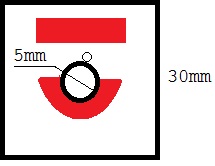
With all this good, I got to wind the coil:
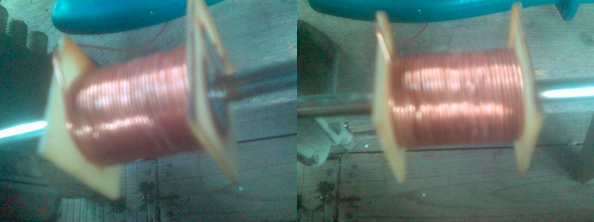
Wound. And according to the same scheme I collected this cunning device.

Here's what it looks like:

Thyristor and mikrik were from old stocks, but I got the capacitor out of a computer power supply unit (there are two of them). From the same power supply unit, a diode bridge and a choke converted into a step-up transformer were later used, because it is dangerous to charge from the outlet, and there is no it in the open field, and therefore I need a converter whose construction I took up. For this, I took the previously assembled generator on the NE555:

And connect it to the throttle:
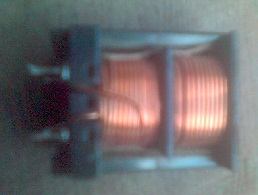
which had 2 windings of 54 turns 0.8 wire. I fed all this from the battery at 6 volts. And what kind of a sorceress - instead of 6 volts at the output (the windings are the same), I got as many as 74 volts. Having smoked another pack of manuals for transformers, I found out:
- As is known, the current in the secondary winding is greater, the faster the current changes in the primary winding, i.e. proportional to the derivative of the voltage in the primary winding. If the derivative of a sinusoid is also a sinusoid with the same amplitude (in a transformer, the voltage value is multiplied by the transformation ratio N), then with rectangular pulses this is not the case. At the front and rear of the trapezoidal pulse, the rate of change of voltage is very high and the derivative in this place is also of great importance, hence the high voltage.
Gauss2k.narod.ru “Portable device for charging capacitors.” Author ADF
A little thought, I came to the conclusion: since the output voltage I have is 74 volts, but 200 is necessary - 200/74 = 2.7 times you need to increase the number of turns. Total 54 * 2.7 = 146 turns. I rewound one of the windings with a thin wire (0.45). The number of turns increased to 200 (in reserve). I played with the frequency of the converter and got the desired 200 volts (in fact 215).
Here's what it looks like:
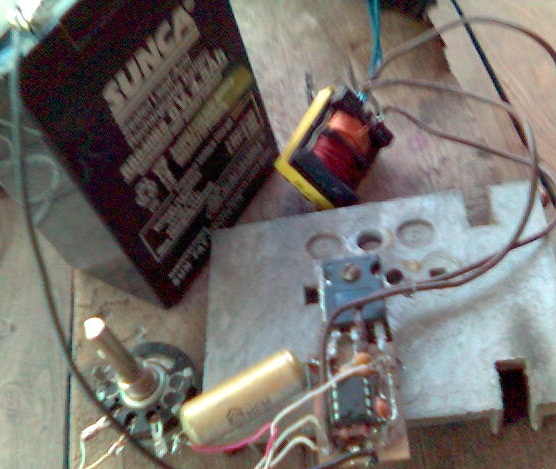
Ugly, but this is a temporary option will then be redone.
Having collected all this stuff, I shot a little:

After shooting, I decided to measure what kind of performance characteristics my gun has. Started by measuring speed.
After sitting in the evening with paper and a pen, I derived a formula that allows us to calculate the speed along the flight path:
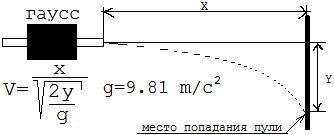
With the help of this clever formula I got:
distance to the target, x = 2.14 m
vertical deviation, y (arithmetic average 10 shots) = 0.072 m
Total:

At first I didn’t believe it, but afterwards the assembled penetration sensors connected to the sound card showed a speed of 17.31 m / s
I was too lazy to measure the mass of the carnation (and there is nothing), so I took the mass that FEMM counted for me (2.45 grams). Found efficiency.
The energy stored in the capacitor = (680 * 10 ^ -6 * 200 ^ 2) / 2 = 13.6 J
Bullet energy = (2.45 * 10 ^ -3 * 17.3 ^ 2) / 2 = 0.367 J
Efficiency = 0.367 / 13.6 * 100% = 2.7%
That's basically all that is connected with a single-stage accelerator. Here is what it looks like:
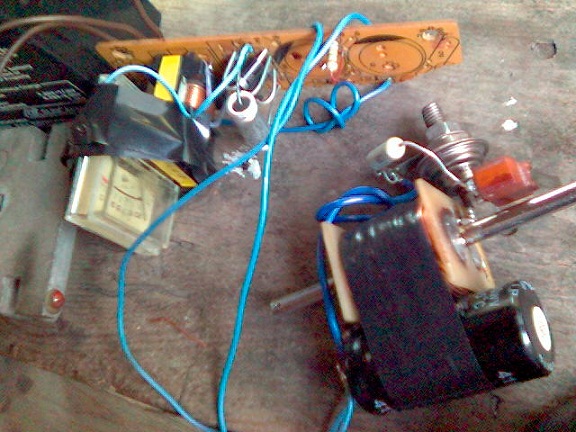
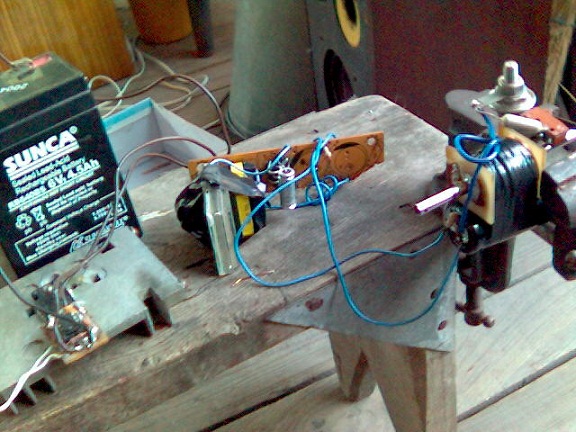
Source: https://habr.com/ru/post/174681/
All Articles